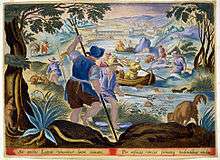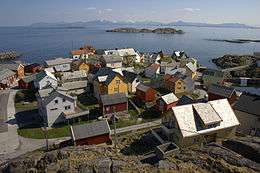Ancient Hawaiian aquaculture

The Hawaiian people practiced aquaculture through development of fish ponds (Hawaiian: loko iʻa), the most advanced fish husbandry among the original peoples of the Pacific. These fishponds were typically shallow areas of a reef flat surrounded by a low lava rock wall (loko kuapa) built out from the shore. Several species of edible fish (such as mullet) thrive in such ponds, and Hawaiians developed methods to make them easy to catch.
The Hawaiian fishpond was primarily a grazing area in which the fishpond keeper cultivated algae; much in the way a cattle rancher cultivates grass for his cattle.[1] The porous lava walls let in seawater (or sometimes fresh or brackish water, as in the case of the "Menehune" fishpond near Līhuʻe, Kauaʻi), but prevent the fish from escaping. Fishponds were located next to the mouth of a stream, so by opening a sluice gate the pondkeeper provided the fish with water rich in nutrients that had passed through inland, terraced pondfields and returned to the stream.[1]
Several fishponds have been restored in recent years. Although fishponds were developed on most islands, the largest number were found in Keʻehi Lagoon, Pearl Harbor, and Kāneʻohe Bay on Oʻahu, and along nearly the entire south shore of Molokaʻi. Few remain today, although Molokaʻi offers the best opportunities to view a Hawaiian loko.
Three different styles of fish ponds are being reconstructed at the Kaloko-Honokōhau National Historical Park on the Big Island of Hawaiʻi. The non-profit ʻAoʻao O Na Loko Iʻa O Maui is restoring Kalepolepo Fishpond also known as Koʻieʻi.e. in Kīhei using a mixture of volunteers and skilled stonemasons.
See also
Notes
References
- Farber, Joseph M (1997) Ancient Hawaiian fishponds: can restoration succeed on Molokaʻi? Cornell University. ISBN 978-0-9659782-0-0.
- Kamakau, Samuel M. (1992), The Works of the People of Old, Honolulu, HI: Bishop Museum Press, ISBN 0-910240-18-3.
- James, Van (2001), Ancient Sites of Maui, Molokai'i and Lana'i, Honolulu, HI: Mutual Publishing, pp. 73–76, ISBN 1-56647-529-5.
- Losch, Tracie Kuʻuipo; Kamahele, Momi, eds. (2008), Hawaiʻi: Center of the Pacific, University of Hawaiʻi Leeward Community College: XanEdu Custom Publishing, pp. 234–235, ISBN 1-58152-579-6.

